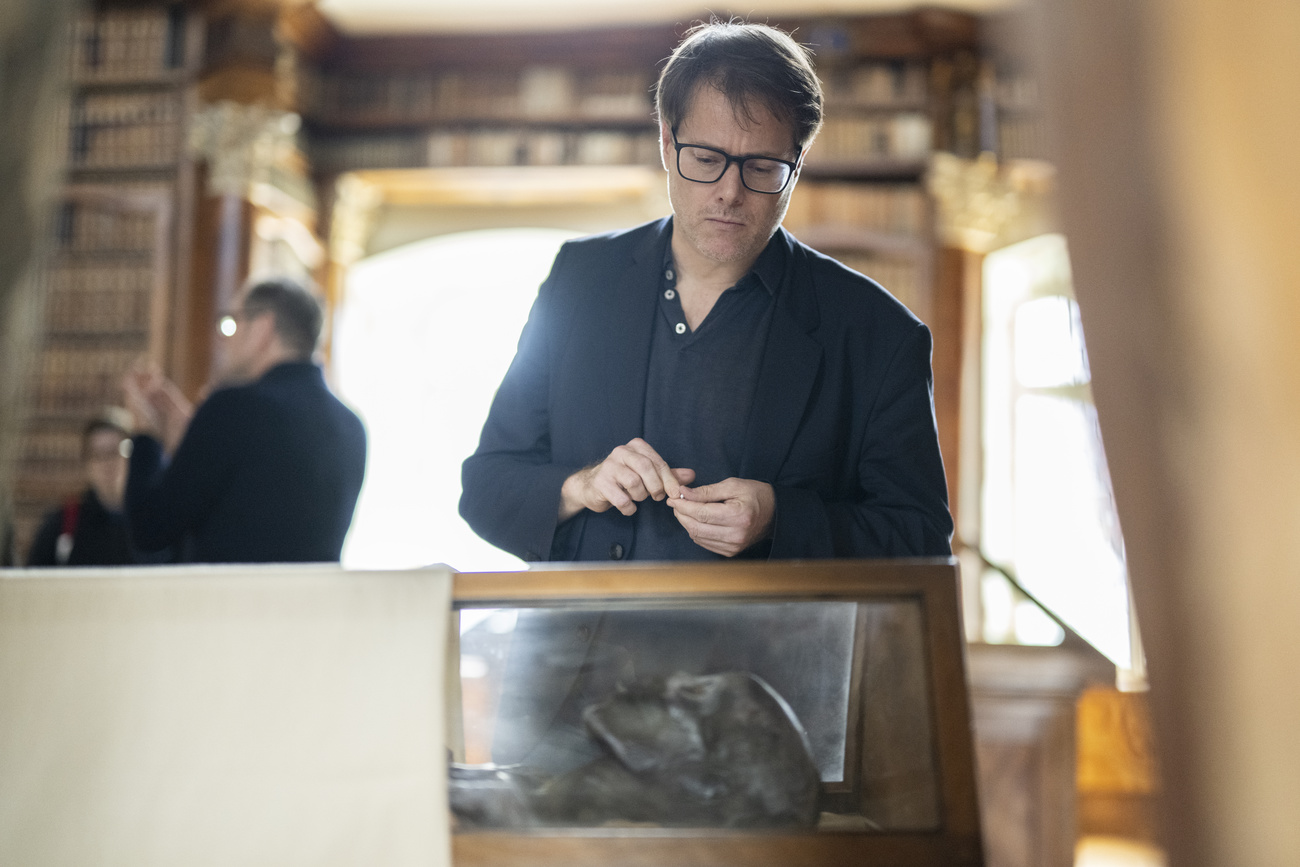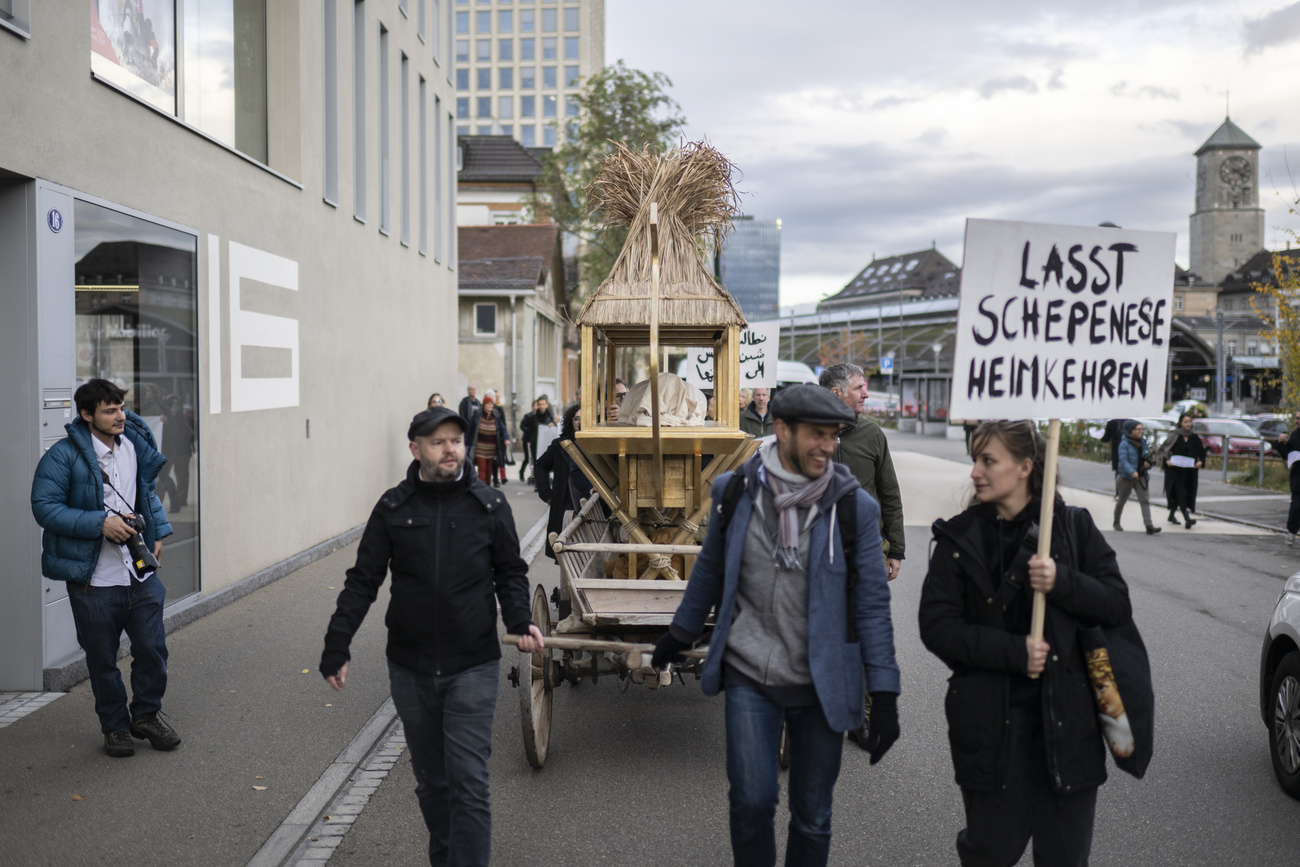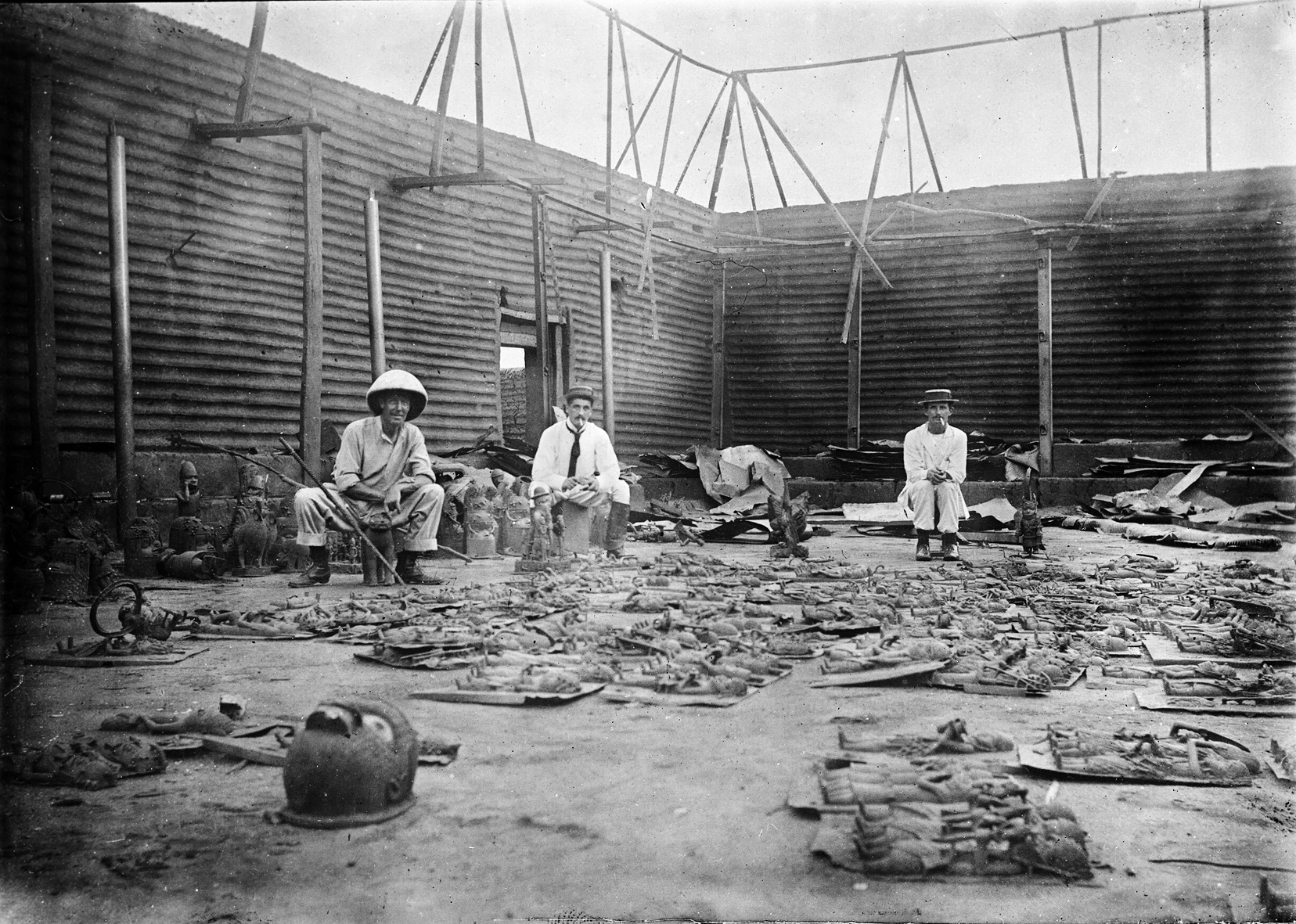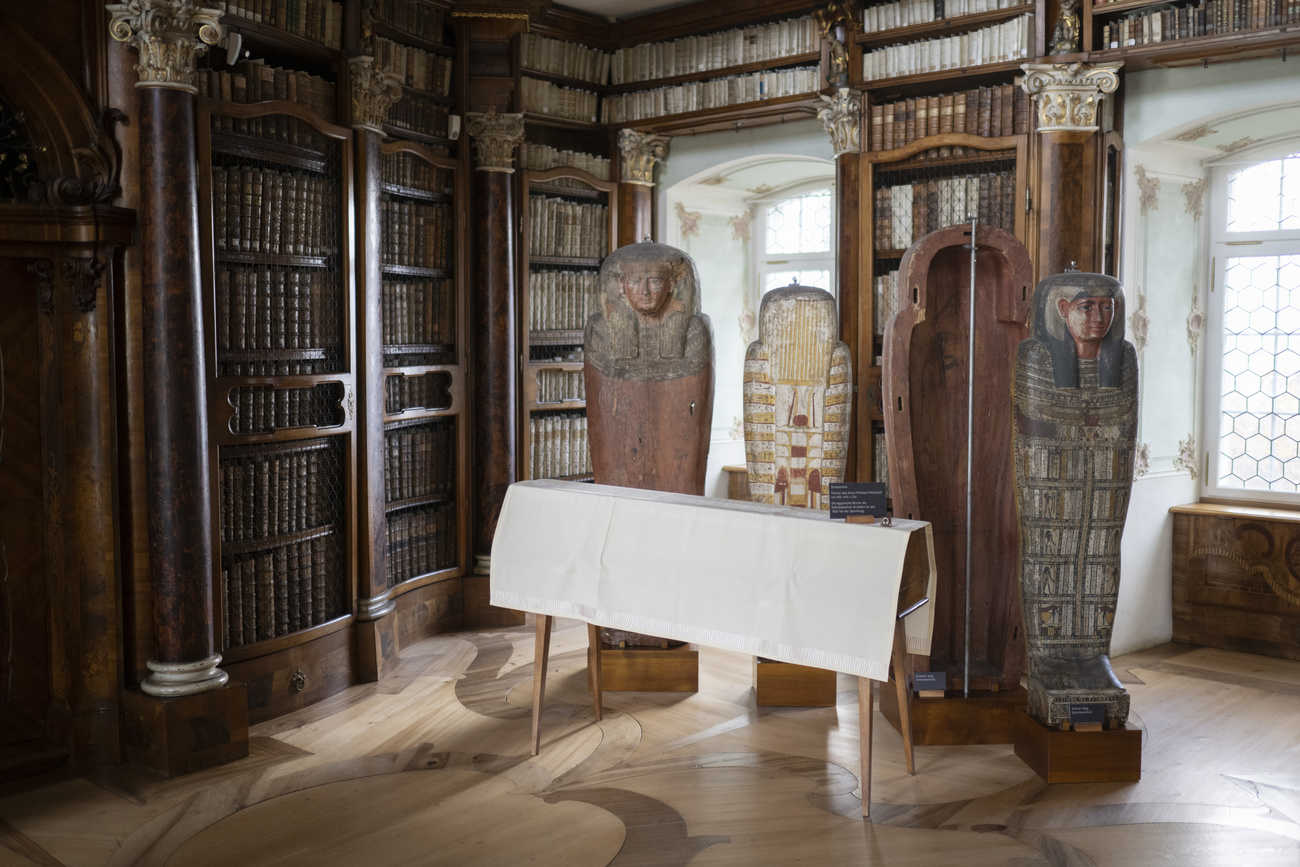
The Egyptian mummy Shep-en-Isis and the thorny question of repatriation

Cultural treasures give nations a sense of identity, which is why stolen cultural property is an emotive issue, not least regarding the colonial empires of the past. Questions also surround cultural artefacts held in Switzerland. One controversy relates to the remains of an Egyptian mummy in St Gallen.
Amid the sumptuous baroque setting of the St Gallen Abbey Library, one of the world’s oldest and most significant historical libraries, lies the Egyptian mummy Shep-en-Isis.
As far as we know, Shep-en-Isis was a priest’s daughter who died in the seventh century BC at the age of around 30. Her resting place, complete with glass coffin, is the “most beautiful mausoleum imaginable”, according to the Abbey Library. But is it Shep-en-Isis’s true resting place?
This debate recently resurfaced when local theatre director Milo Rau won the Kulturpreis, St Gallen’s most prestigious cultural award, in November 2022. In his acceptance speech, Rau announced that he would donate his CHF30,000 prize money towards helping return the mummy to Egypt. He staged an artistic stunt, creating a mock-up of the mummy in her coffin, which he proceeded to wheel through the city. The Shep-en-Isis exhibition is a “constant moral irritation”, Rau lamented.

He and other signatories also penned the St Gallen Declaration for Shep-en-Isis, calling the exhibition “thoughtless” if not “predatory and disrespectful” as well as being unacceptable for a city of culture like St Gallen.
Originally buried in Luxor
Shep-en-Isis is originally believed to have been buried in Egypt at the Theban Necropolis, across the Nile from Luxor. According to Rau and his fellow signatories, robbers snatched her from her grave. However, the Abbey Library says that this version of events cannot be proved.
It argues in a statement on the St Gallen Declaration that it is inaccurate to claim Egypt was plundered in the 18th century. The Abbey Library says that instead French, British and, later, German scientists began to intensively study the culture of ancient Egypt after Napoleon’s Egyptian campaign of 1798–99. This is in complete contrast to the Egyptians themselves, who gave their own heritage scant regard.
The Abbey Library cites the example of Mohammed Ali, the viceroy of Egypt who in 1830 called one of the now world-famous pyramids of Giza a “pitiful heap”, saying that he wanted to use the “rubble” to build canals. The then French consulate in Alexandria stepped in to prevent the pyramid’s destruction, adds the statement.
A question of dignity
Shep-en-Isis ended up in St Gallen around 200 years ago. Philipp Roux, a German businessman, is said to have purchased her remains in Alexandria along with two attendant wooden sarcophaguses. He then sent them to a friend, the politician Karl Müller-Friedberg, who was the founding father of the canton of St Gallen. It is not entirely clear whether Müller-Friedberg received the mummy as a gift or whether he bought it himself.
After arriving in St Gallen, Shep-en-Isis was unwrapped down to the shoulders by a group of invited scholars, according to accounts at the time. Following a ceremony, the guests were each allowed to take a piece of the mummy’s bandages home with them. Was this the lack of respect to which Rau is referring?
The German ethnologist Wiebke Ahrndt recently said that the social elites in the 19th century often held mummy “unwrapping parties”, whereby mummies would be unwrapped for entertainment at private parties – not only in Europe, but also in Egypt. This past could no longer be undone. Ahrndt, who has written a set of guidelines on caring for human remains in museums and collections, believes that mummies can be exhibited, provided human dignity and the sensitivities of the country of origin are respected.
Not only do Egyptian museums also exhibit mummies, but it was even legal to export mummies until 1983, says Ahrndt. The people who run the Abbey Library are keen to stress that there is no voyeurism involved regarding Shep-en-Isis, and that they observe standard practice on the display of human remains at museums. Photos that they have provided to the media have even been taken from a distance, showing the mummy’s face from a side-on angle.

Are these explanations sufficient to keep Shep-en-Isis in St Gallen? The Catholic administration of canton St Gallen, the body that owns all the Abbey Library holdings, has responded to Rau’s criticism, and decided to re-examine the issue, it appears. Three weeks after Rau’s stunt on the streets of St Gallen, the administration’s management board said that it would “look seriously” into the possibility of returning Shep-en-Isis to her homeland, in consultation with the Egyptian authorities.
Property plundered by the Nazis
In Switzerland, probes into the origin of foreign artistic and cultural property, referred to as provenance research, mainly relate to stolen Nazi gold and art from the Second World War. In 2002, a commission of experts headed by the historian Jean-François Bergier submitted a comprehensive report to the Swiss Federal Council (executive body) detailing how Swiss firms cooperated closely with the Nazi regime.
Artworks that changed hands during the Nazi era in Germany (1933–1945) ended up in private and public collections. Finding out whether the Nazis looted these artworks is now imperative. The Museum of Fine Arts Bern, which accepted the Nazi era trove of art dealer Cornelius Gurlitt in 2014, is leading by example in this regard.
The controversy surrounding Gurlitt proved to be a turning point, with the Federal Council subsequently deciding to set aside CHF500,000 every year to allow Swiss museums to carry out provenance research. It is a small amount of money but at least it gets the ball rolling, says Joachim Sieber, who chairs the Swiss provenance research working group (SAP).
Colonial legacy into political spotlight
Swiss provenance researchers must now wade through another weighty issue: cultural property derived from trade in the colonial era. This may seem paradoxical, given that Switzerland has never had any colonies. However, Switzerland “was and is part of Europe’s colonial conversation”, according to Sieber.

More
Switzerland and its colonists
Precisely because it was not a colonial power, both Switzerland and its businesses were regarded as trustworthy partners by the new nations that achieved autonomy or outright independence from their European colonial rulers after 1945.
Bern is slowly starting to revisit this legacy, as numerous parliamentary debates, motions and interventions have already shown, says Sieber, “even if this process is painful as it poses awkward questions with regard to Swiss neutrality and Switzerland’s view of itself as a nation built on equality, solidarity and humanitarianism”.
Part of a worldwide debate
Various European countries are now wrestling with the implications of looted art from the colonial era. Some nations, like the Netherlands, have made official apologies. The Belgian and British royal families have expressed regret, but made no apology, for their respective countries’ past actions. Others have backed their words with actions. At the end of 2022, for example, Germany became the first nation to begin returning its Benin Bronzes to Nigeria.
The Kingdom of Benin, in today’s Nigeria, was attacked by British colonial troops in 1897. Thousands of brass and bronze sculptures were plundered from its royal palace and traded as artworks, ending up in collections around the world. Nigeria now wants these items to be recognised as plundered art.

More
Looted colonial art: ‘There are no limits to restitution’
It is less well known that Swiss museums also house 100 or so items suspected to have come from Benin.
Eight Swiss museums have come together under the leadership of Zurich’s Rietberg Museum to form the Swiss Benin Initiative (SBI). Funded by the Federal Office of Culture, the SBI seeks to ensure transparency for researchers as well as open dialogue with Nigeria. A key element in how we deal with cultural property is indeed dialogue.
Speaking on Swiss public radio, RTS, in 2017 after French President Emmanuel Macron’s pledge to return African treasures, the Geneva-based anthropologist and museologist Bansoa Sigam stressed that the global north and south needed to become equal partners. De-colonisation meant “being honest with your own history and finding solutions”. This could lead to the “common global history” advocated by Swiss historian Bernhard C. Schär, who believes it is a mistake to view and teach the history of Europe in isolation. History is always the result of interaction between people, he says.
Repatriation is not the only solution
According to estimates, over 90% of Africa’s cultural heritage was looted during the colonial era and is currently held not in Africa but in Europe and the United States. Are all these treasures now to be returned? No, says Joachim Sieber, repatriation is not the only solution. For example, another option is for cultural property to be returned and then re-purchased or loaned out on a long-term basis.
Museums can also label exhibited artefacts with the names of their original owners. What matters, he adds, is finding a solution in consultation and cooperation with the countries of origin. To return to the original example in this article, there is, therefore, a distinct possibility that the Egyptian government will not even want Shep-en-Isis back and instead make an alternative amicable arrangement with the Catholic administration in St Gallen.

In the meantime, Shep-en-Isis currently attracts some 150,000 visitors a year. Every evening, staff at the Abbey Library honour her with an end-of-day ritual. Once all visitors have left the building, they cover the glass coffin with a white veil and recite the mummy’s name – an act of remembrance and a gesture of respect for the Egyptian concept of eternal life.
Rich countries are the “usual suspects” when it comes to plundered art, but Switzerland itself was once the victim of a heist. The Capuchin friars of Fribourg have kept a beady eye on their valuable library for centuries but were evidently looking the other way when one of the books in their safekeeping, the “Ship of Fools” dating from the 15th century, was stolen during the Second World War.
This exceptional work, dating back to the early days of the printing press, resurfaced in 1945 at a New York City book dealer. It was later gifted to one of the world’s largest libraries, the Library of Congress in Washington. The friars were left empty-handed again in 1975, when a thief posing as a Vatican librarian made off with around 20 valuable old manuscripts.
Like the “Ship of Fools”, these works disappeared and were forgotten – until the beginning of the 2000s, when an employee of the Fribourg Cantonal and University Library (KUB) found out the following: firstly, that the stolen manuscripts had been sold at auctions in Munich in 1975 and 1976, and secondly, that the missing copy of “Ship of Fools” had been located in Washington. The KUB made subsequent enquiries to locate and recover the 20-odd stolen prints.
At the end of 2022, the Library of Congress in Washington returned the “Ship of Fools” to canton Fribourg. The book is now kept at the KUB, where it is available for students and scholars to view.
Further information (in German and French): revue.link/narrenschiffExternal link
This article first appeared in Swiss ReviewExternal link.

In compliance with the JTI standards
More: SWI swissinfo.ch certified by the Journalism Trust Initiative































You can find an overview of ongoing debates with our journalists here . Please join us!
If you want to start a conversation about a topic raised in this article or want to report factual errors, email us at english@swissinfo.ch.